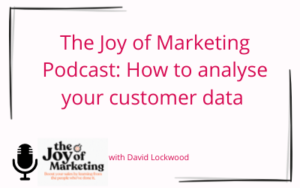Now more than ever you need to listen up.
As a multi-channel retailer, you have to wrestle with all manner of challenges.
Your customers are constantly ‘talking’ to you, through what they buy, how they buy it.
And this will be influenced both by what is going on in the world – and how they see this changing world. So let’s start from a macro perspective.
What has been happening…
At the end of last year, the talk was of looming recession, both here and around the developed world. Many economic pundits believed it was inevitable.
So where are we now?
Well, inflation adjusted GDP (the value of all goods and services produced by an economy in a given year) is trundling along at just below pre-Covid levels.
Current forecasts for 2023 are between negative 2.5% and negative 0.5% – so not a rapidly improving picture, but also not getting significantly worse
But as with any economic forecast, the old adage stands true – put two economists in a room and you’ll get two opinions.
The BCC thinks the UK will avoid a technical recession – others believe we will be the only G7 country to actually suffer a recession.
Either way, times are tough.
So how is this affecting the sale of goods or services to customers?
Overall Retail (excluding fuel) in 2022 was +5% Revenue on the prior year.
That doesn’t seem too bad?
However, volumes were -4% down and inflation was running at 8%. Which means the revenue growth figure is a significant overstatement of real performance.
Drilling down into the direct to consumer sector, there is some good news.
Internet sales as a % of total retail are still above the long-term trend. But only just, and it is still adjusting downwards, with a 3.5 % drop on PY since Apr 2022.
At trend levels, with a peak decline of 3.7% in December, we would expect the Year on Year figures to stabilise in Q2.
Multi-channel is masking the full story…
For a solid bellwether for our industry, it’s always worth looking at data from IMRG.
IMRG is widely recognised as the UK’s authority on ecommerce market data, analysis and insight. Their data largely supports what we’re saying here – but shows an average of just 5% down in H2.
However, many retailers tell us they are feeling more of an impact than this.
This graph shows much more clearly the down turn in December driven at least partially by the Royal Mail Strikes (see right).
But this is where the power of multichannel is masking the full story for some retailers.
At 10% down, it feels like 20% because of inflation.
As always, different sectors have had different impacts…
Gifting has had a really difficult year.
Clothing started very strong and has tailed off.
Health & Beauty is coming back to average after a challenging period.
The changes and challenges continue…
Sometimes it feels like you are running to stand still.
The cost increases over the last 2 years have not been compensated by increasing responses or yields. There are the continued changes in the paid search space (and the blurring of the lines with Pmax). And then there is the never-ending pace of technological development.
GA4 and the changes in the way web behaviour is measured will soon make YoY comparisons difficult unless you have been parallel running for a significant time. (GA4 collects both website and app data to better understand the customer journey. It uses event-based data instead of session-based, and includes privacy controls such as cookie-less measurement, as well as behavioural and conversion modelling).
What’s more, turbulent economic times lead to customers being nervous about the unknown – and, of course, you are an unknown to all but you active customers.
Reasons to be cheerful?
As of now, the UK is not in a recession, inflation is allegedly on the wane, GDP is pretty much back to pre Covid levels, business confidence appears positive and while consumer confidence is still well behind last year appears to be on the up.
However, the headwinds remain. Has the Bank of England got a good record when it comes to predicting inflation? It may dip but tell that to people paying 18% more for their groceries. We have yet to see the impact of 4.25% interest rates.
Does food inflation together with the collapse of Silicon Valley Bank and the Credit Suisse rescue mean nailed on interest rate rises to 4.75% by mid year?
And, in the words of a famously ‘Fawlty’ hotelier: “don’t mention the war”. The conflict in Ukraine looks far from resolved.
Six trends for 2023…
Let’s highlight six trends, reflecting shopping polarisation, value for money, innovation, efficiency, ESG and people.
1.) Luxury and Discounters are faring better than mid market
2.) Last year we saw a shift from Volume to Quality. That is continuing.
3.) Innovation doesn’t mean spending all our cash in the Metaverse. Innovation for your customer base maybe a more seamless integration of existing channels, or a more personalised journey.
4.) It doesn’t matter where your efficiency gains are. Overall, you need a better understanding of your marketing channel mix. You need to accelerate transformation through technology. You need to build greater supply chain resilience and sustainability and you need to invest in financially sustainable business models.
5.) Environmental, Social & Governance (ESG). This isn’t just about Net Zero. And it needs to be more than paying lip service. Customers want Value with Values. Or they will go elsewhere.
6.) People are not some homogenous group with marginally variable needs. And that doesn’t just apply to your customer. Your people – your team – need to be excited, enthused and empowered. In a time of significant change and economic uncertainty, the best organisations maintain a laser focus on their people and their wellbeing.
Remember, at its core, retail is a people business.
So, what about AI?
If retail is a people business, how will AI influence the sector in 2023?
Here’s are six ways, according to our trusted friend, Chat GPT:
- AI can be used to personalise the shopping experience for individual customers. For example, it can be used to recommend products to customers based on their browsing and purchase history, as well as their social media activity.
- AI can be used to analyse data from various sources (such as customer data, sales data, and social media data) to make predictions about customer behaviour and trends in the market. This can help retailers to make more in.
- AI can be used to optimise the management of inventory. For example, it can be used to predict demand for products, track inventory levels in real-time, and automate reordering processes. form decisions about what products to stock, how to price them, and how to market them.
- AI can help in automating repetitive, mundane tasks like price checking, stock checking and much more.
- AI can be used to create chatbots that can answer customer questions, provide recommendations, and even complete transactions without the need for human assistance.
- AI can be used for automated image recognition for products in online retail, which allows for easier product search and category browsing.
Your priorities for 2023
The mantra ‘listen, react, respond’ holds true, especially in today’s uncertain environment.
Listen to your customer: your customer is talking to you, take time to hear them. They talk through purchases made – through what they buy, how they buy it, how they reach your website and interact with it, returns sent, reviews, email engagement, bounce rates, dwell time, social comment and so on. Make sure you’re set up to listen and react to your changing customer signals. Tap in to what they say.
Now is the time to really understand how your marketing investments convert into profit. Don’t let perfect be the enemy of progress here. Be better tomorrow than you are today.
Think about AI as a new team member to deploy and onboard in the same way. A lot of automated roles have a degree of repeated tasks that are generally loathed. So, could automation save 10% on your headcount?
Live your Environmental/Social & Governance policy/beliefs right through the business. Again, remember it’s not just for your customers – but for you and your teams. You need to realise that the youngest part of the workforce is more motivated by ambitions and practices in this area than ever before. Ignore it at your peril.
While you can measure almost everything, you shouldn’t. Understand what the core metrics are that drive the success of your business are and double down your focus where it matters.
Make sure you understand what your leading (most predictive) metrics are and be sure to have a measurement frequency that allows you to spot behavioural changes early – and then, of course, make sure you do something about it!
Are you where your customer is being influenced? Seek out editorials on favourite media sites, integrated ads on blogs, content on most used platforms. Be where they are.
And, almost most importantly, have a clarity of vision that empowers bold decision making.
All-in-all, you need to understand the marketing mix and optimise it, then optimise within it.
This is where Tapestry can help.
If you’re looking to grow profitably, no matter what the markets and the world throws at you, get in touch with us at [email protected].
We’ll be happy to chat with you on how you can use your customer data to not just serve your existing customers better but also how you can discover and best recruit your new hero customers to power the growth of the future.




